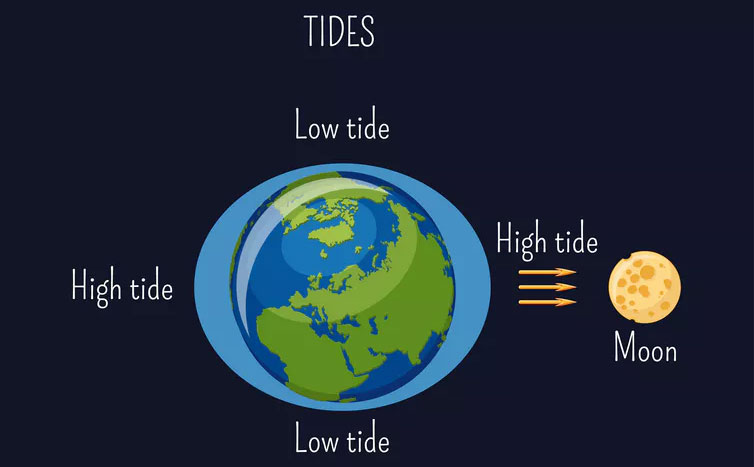Why does such a distant Moon affect the tide on Earth?
The short answer is that the Moon's gravity pulls water on Earth's oceans towards it. Although the Moon is very far away, it is large enough for its gravity to absorb water on Earth.
Before we learn more about how the Moon affects the tide, let's see what the tide is.
is the water level rising and falling on the oceans (and the lake, and even in your water cup, but it's very small so you don't see it).
When the sea level rises to the highest level, we call it the rising tide, and when it reaches the lowest level, we call it the ebb tide.
Each rising and falling tide is called a tidal cycle . If there is a high tide and a low tide in a day, it is called the diurnal cycle. If there are two high tide periods and two low tide periods in a day, this is called the semi-diurnal cycle.
The most influential moon is not the only factor affecting the tide. The sun and the Earth also affect the tide. Let's find out first about the influence of the Moon.
Tide with the Moon
The moon affects the tide due to its gravity . You will see that every time you jump, you will fall to the ground. That's because Earth's gravity pulls you down.

The Earth revolves around itself, causing the tide to appear on the opposite side of the Earth compared to the Moon.
The moon also has its gravity and the Moon's gravity pulls water on Earth (and pulls us too) towards it. But the gravitational pull of the Moon draws us weaker than the Earth's gravity, so we don't notice it, and the oceans are more recognizable. Water is drawn towards the Moon causing high tide on the Earth side to the Moon.
The influence of the Earth
If the Moon causes tides on one side of the Earth, what causes the tide on the other side?
The Earth rotates around its axis, so we have day and night. The Earth rotates around the axis, meaning that the rising tide occurs on the hidden side of the Earth compared to the Moon.
These two tides cause two low tides.
The influence of the Sun.
Like the Moon and Earth, the Sun also has its gravity and affects the tide. Although the Sun is much larger than the Moon and has a greater gravity, it is so far away that its traction on the Earth's sea is only about a quarter of the Moon's traction.
Even so, it still has an impact. When the Sun and Moon align with the Earth (ie on the full moon and the new moon), their gravity combined together causes very high tide and ebb tide is also very deep.
When the Sun and Moon are perpendicular to each other (on the moon and the moon is gradually rounding), the sun reduces the attraction of the Moon, so the tide is low and the tide is lower.
Thus the Moon influences the tides due to gravity, but the sun's gravity and the rotation of the Earth also affect tidal levels.
- 'King's tide' raged on the earth
- Super moon can create 'king tide' flooding coastal areas
- 'Super moon' is about to appear
- The moon is leaving Earth with the fastest speed
- Never see the full Moon from Earth
- Why is there a tidal up and down phenomenon?
- Obsessive super moon
- Strange facts about Super Moon
- Water on the Moon can affect telescopes
- Settling on 'Moon Palace' will no longer be a distant dream
- If the earth has no moon ...
- The moon is separated from Earth?
 'Fine laughs' - Scary and painful torture in ancient times
'Fine laughs' - Scary and painful torture in ancient times The sequence of numbers 142857 of the Egyptian pyramids is known as the strangest number in the world - Why?
The sequence of numbers 142857 of the Egyptian pyramids is known as the strangest number in the world - Why? History of the iron
History of the iron What is alum?
What is alum? This Abundant Mineral on the Moon Could Power Humanity for Thousands of Years
This Abundant Mineral on the Moon Could Power Humanity for Thousands of Years  The Strange Disease That Affects Everyone Who Has Ever Set Foot on the Moon
The Strange Disease That Affects Everyone Who Has Ever Set Foot on the Moon  What would a day on the Moon be like for astronauts?
What would a day on the Moon be like for astronauts?  First photo of Mars' strangely shaped moon
First photo of Mars' strangely shaped moon  The biggest supermoon of the year is about to light up the world's skies
The biggest supermoon of the year is about to light up the world's skies  New research shows that Earth has a new 'Moon'
New research shows that Earth has a new 'Moon' 